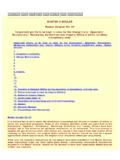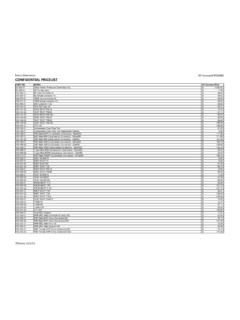Transcription of The Present and Future Of Financial Risk …
1 THE BUSINESS SCHOOL FOR Financial MARKETS The University of Reading The Present and Future Of Financial Risk management ISMA Centre Discussion Papers in Finance 2003-12 First Version: 10 September 2003 This Version: 20 February 2004 Carol Alexander Chair of Risk management and Director of Research ISMA Centre, University of Reading, Whiteknights, Box 242, Reading RG6 6BA, UK This paper is based on two keynote speeches presented at: BM&F International Derivatives and Financial Markets Conference Campos de Jordao, Brazil, August 20th 23rd, 2003 & CFS Workshop on the Future of Risk management Frankfurt, Germany, November 3rd 4th, 2003 Copyright 2003 Carol Alexander.
2 All rights reserved. The University of Reading ISMA Centre Whiteknights PO Box 242 Reading RG6 6BA UK Tel: +44 (0)118 931 8239 Fax: +44 (0)118 931 4741 Email: Web: Director: Professor Brian Scott-Quinn, ISMA Chair in Investment Banking The ISMA Centre is supported by the International Securities Market Association Abstract Abstract Current research on Financial risk management applications of econometrics centres on the accurate assessment of individual market and credit risks with relatively little theoretical or applied econometric research on other types of risk, aggregation risk, data incompleteness and optimal risk control.
3 We argue that consideration of the model risk arising from crude aggregation rules and inadequate data could lead to a new class of reduced form Bayesian risk assessment models. Logically, these models should be set within a common factor framework that allows proper risk aggregation methods to be developed. We explain how such a framework could also provide the essential links between risk control, risk assessments and the optimal allocation of resources. JEL Classifications: C11, C13, G20 Keywords: Financial risk assessment; risk control; RAROC; economic capital; regulatory capital; optimal allocation of resources.
4 Contacting Author Details: Carol Alexander ISMA Centre, University of Reading, Whiteknights, Box 242, Reading, RG6 6BA, Tel: +44 118 378 6134; fax: +44 118 378 4741. E-mail address: This discussion paper is a preliminary version designed to generate ideas and constructive comment. Please do not circulate or quote without permission. The contents of the paper are presented to the reader in good faith, and neither the author, the ISMA Centre, nor the University, will be held responsible for any losses, Financial or otherwise, resulting from actions taken on the basis of its content.
5 Any persons reading the paper are deemed to have accepted ISMA Centre Discussion Papers in Finance 2003-12 Copyright 2003 Carol Alexander. All Rights Treserved. 3 Introduction The role of risk management in Financial firms has evolved far beyond the simple insurance of identified risks , to a discipline that centres on complex econometric and Financial models of uncertainty. Financial risk management has been defined by the Basel Committee (2001) as a sequence of four processes: the identification of events into one or more broad categories of market, credit, operational and other risks and into specific sub-categories; the assessment of risks using data and a risk model; the monitoring and reporting of the risk assessments on a timely basis; and the control of these risks by senior management .
6 Of the trends in Financial markets that have had a significant impact on risk management practices today, deregulation has been a main driving force. Since the 1970s the deregulation of capital flows has led to increased globalization (Sverrisson and Van Dijk, 2000); deregulation of industries has enabled the rapid expansion of new companies such as Enron (Bodily and Bruner, 2002; Bratton, 2003); and with the deregulation of Financial operations new risks have been acquired with some banks offering insurance products and insurance companies writing market and credit derivatives (Broome and Markham, 2000).
7 Over-the-counter derivative markets rapidly overcame all others in notional size but capitalization, on the global scale, decreased during this period and by the early 1980s some individual banks, if not national banking industries, had become highly vulnerable. As a result the supervision and regulation of banks and other Financial firms has increased. In particular, capital adequacy requirements have been extended to cover more types of The first Basel Accord in 1988 covered only credit risks in the banking book; the Basel 1 Amendment in 1996 extended this to market risks in the trading book; and now the new Basel 2 Accord that will be adopted by all G10 and many other countries in 2007 refines credit risk assessments to become more risk sensitive and extends the calculation of risk capital to include operational risks .
8 Also in Basel 2, minimum solvency ratios will now be applied to asset management and brokerage subsidiaries, and well as to traditional banking operations. Some Financial services have become concentrated into the hands of very few firms. Primarily this has been the result of deregulation leading to greater competition (Fraser and Zardkooi, 1999; Stiroh and Strahan, 2003) but increased regulation of banking activities has also played a role. Under the new Basel Accord some services such as agency and custody will for the first time attract regulatory capital charges and consequently the best economic solution may be to out-source the service.
9 On the other hand all types of Financial services insurance, asset management and banking are being merged into one large complex banking organization. This consolidation of services highlights the importance 1 As well as providing a margin for losses, the imposition of minimum solvency ratios might reduce the incentives to take risks ; however there is evidence that capital requirements are ineffective for the latter (Blum, 1999; Jones, 2000). ISMA Centre Discussion Papers in Finance 2003-12 Copyright 2003 Carol Alexander. All Rights Treserved.
10 4of a firm-wide risk management function that is able to examine the total risks of the whole organization (Berger, Demsetz and Strahan, 1999). Consequently, changes in regulatory supervision of banking activities include a move away from product based capital requirements to rules based capital requirements that may be uniformly applied across all subsidiaries in a large complex group so that risks and returns from all activities can be assessed on a comparable basis and properly aggregated. Disintermediation in the traditional banking industry has played an important role in changing the structure of Financial institutions.





